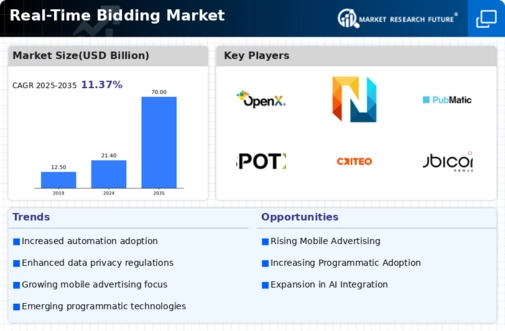Growing Mobile Advertising
The proliferation of mobile devices is significantly influencing the Real-Time Bidding Market. As consumers increasingly engage with content on smartphones and tablets, advertisers are compelled to adapt their strategies to capture this audience. Mobile advertising is projected to represent over 50 percent of total digital ad spending by the end of 2025. This shift necessitates the implementation of real-time bidding strategies that cater specifically to mobile platforms. Advertisers are focusing on optimizing their campaigns for mobile users, utilizing location-based targeting and personalized content to enhance engagement. Consequently, the Real-Time Bidding Market is likely to witness accelerated growth as mobile ad spending continues to rise, reflecting changing consumer behaviors and preferences.
Regulatory Changes and Compliance
The Real-Time Bidding Market is navigating a complex landscape of regulatory changes and compliance requirements. As governments worldwide implement stricter data privacy laws, advertisers must adapt their strategies to ensure compliance while still achieving effective targeting. Regulations such as the General Data Protection Regulation (GDPR) and the California Consumer Privacy Act (CCPA) have prompted a reevaluation of data collection and usage practices. This evolving regulatory environment may pose challenges for advertisers, but it also presents opportunities for those who can innovate within these constraints. Companies that prioritize transparency and consumer trust are likely to thrive in the Real-Time Bidding Market, as compliance becomes a key differentiator in a competitive landscape.
Emergence of New Advertising Formats
The Real-Time Bidding Market is witnessing the emergence of new advertising formats that cater to evolving consumer preferences. Innovations such as video ads, interactive content, and augmented reality experiences are gaining traction among advertisers. These formats not only enhance user engagement but also provide advertisers with more dynamic ways to connect with their audiences. In 2025, it is anticipated that video advertising will account for a substantial share of the market, driven by its effectiveness in capturing attention. As advertisers experiment with these new formats, the Real-Time Bidding Market is likely to evolve, offering diverse opportunities for brands to engage consumers in more immersive and impactful ways.
Advancements in Artificial Intelligence
Artificial intelligence is playing a pivotal role in transforming the Real-Time Bidding Market. The integration of AI technologies enables advertisers to analyze vast amounts of data in real-time, facilitating more informed bidding strategies. AI algorithms can predict user behavior, optimize ad placements, and enhance targeting precision. This technological advancement is expected to drive efficiency and effectiveness in advertising campaigns. In 2025, it is estimated that AI-driven solutions will account for a significant portion of the market, potentially exceeding 30 percent. The ability to leverage machine learning for predictive analytics is likely to enhance the overall performance of advertising efforts, making the Real-Time Bidding Market more competitive and responsive to market dynamics.
Increased Demand for Programmatic Advertising
The Real-Time Bidding Market is experiencing a notable surge in demand for programmatic advertising solutions. This trend is driven by advertisers seeking more efficient and targeted ways to reach their audiences. According to recent data, programmatic advertising accounted for approximately 85 percent of all digital display ad spending in 2025. This shift towards automated buying and selling of ad inventory is reshaping the landscape of digital marketing. Advertisers are increasingly leveraging data analytics and machine learning to optimize their campaigns, thereby enhancing return on investment. As a result, the Real-Time Bidding Market is poised for substantial growth, with projections indicating a compound annual growth rate of over 20 percent in the coming years. This evolution reflects a broader industry trend towards data-driven decision-making and real-time optimization.

















Leave a Comment